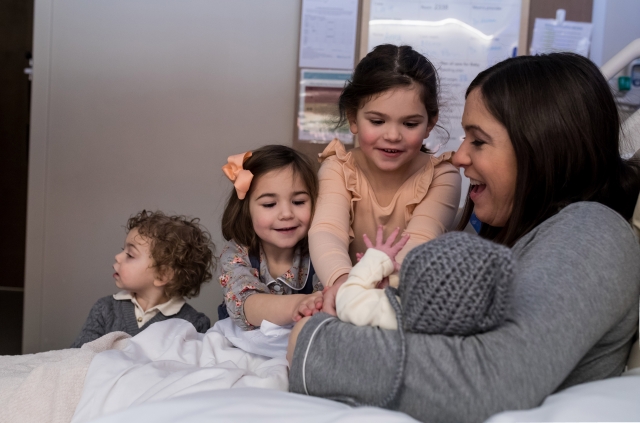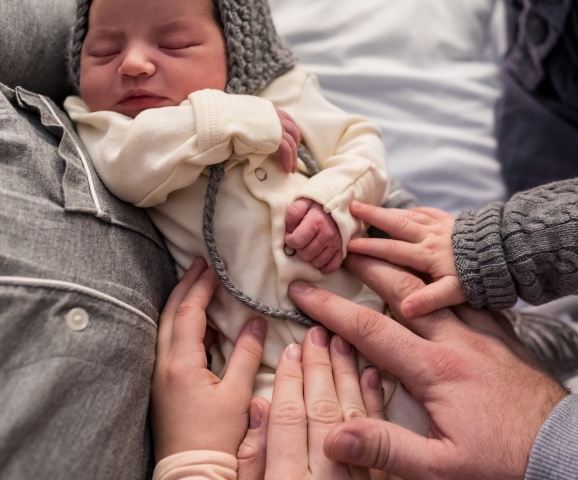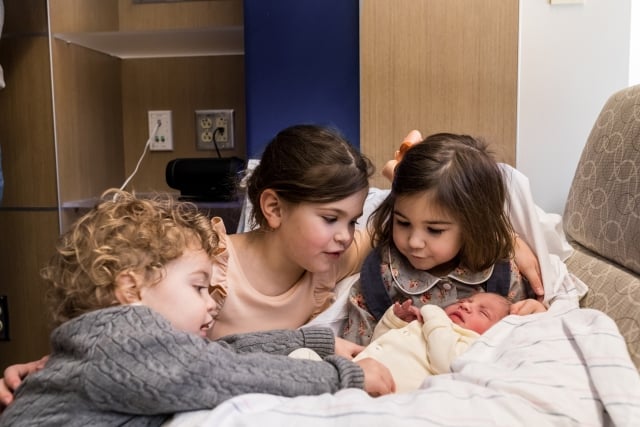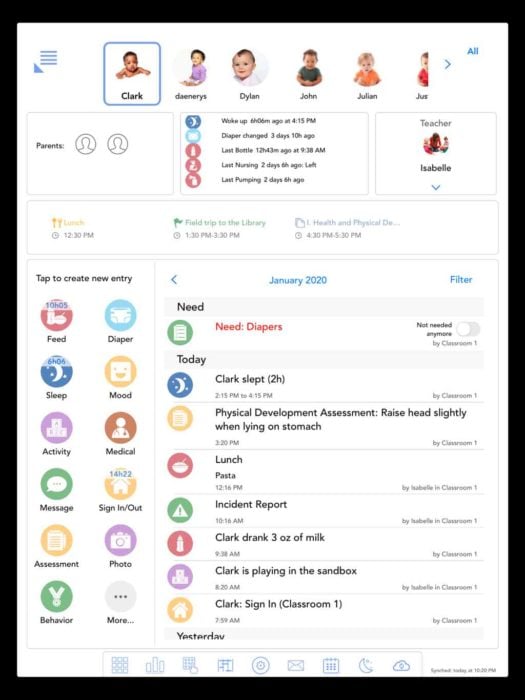
Behind the curtain, I could hear giggles. The kids were waiting for the big reveal: to meet their new sibling.
Nine hours after her birth, they arrived at the hospital, got the cue and bolted into the room, breathless with excitement.
“It’s a girl!”
Euphoria.

(The pictures by Rebecca Slater speak for themselves. I am so grateful we hired her to capture their first meeting.)
Since that moment, the kids’ affection for Baby Kate has continued to swell. I couldn’t have hoped for a warmer embrace – and I’m hard-pressed to identify which sibling is most obsessed with her. It usually feels like a three-way tie. Kate is their first inquiry when they rise and their final request before they fall asleep.
Conventional wisdom suggests certain measures during pregnancy to prepare a young child for a new sibling: read books about welcoming a baby, provide a baby doll, talk often about the pregnancy.
But in our experience, these steps only go so far. Everything is just so abstract until Baby arrives. That’s when the real groundwork begins to open the hearts of big siblings. Here’s what has worked best for us.
10 ways to cultivate sibling bonding
1. Make the hospital visit special. Wear a fun outfit, bring a balloon, convey excitement. Ask if the hospital has big-sibling wristbands or stickers to signify their special status. (The Mother Baby Center at United Hospital in St. Paul has both, and my kids loved them.)

2. Let them in. It can be scary to allow toddlers up close – especially when their sticky hands gravitate to Baby’s eyes or mouth – but as long as you’re right there too, guiding and redirecting, you should be fine. Being able to touch Baby is a crucial part of bonding. Let them hold the baby in supported settings. Encourage gentle hugs. Lay the baby in big sibling’s bed at night for a minute.

3. Give a present from the new baby. I wrapped and packed a gift in our hospital bag: a Melissa & Doug wooden stable with horses. It was a hit. It’s as simple as it is effective for young kids: A gift from the new baby creates a positive association. It can remind, in the ensuing weeks, that an often demanding baby will not only be taking but giving.
4. Play up Baby’s responsiveness. You might not have much to work within the early weeks, but favorably interpret every little face and sound. “Oh, the baby liked that!” “You made the baby happy!” “You calmed the baby down!”
My kids have an active imagination when it comes to deciphering what their newborn sister is communicating – and what they’re looking for (whether or not it’s there!) are the makings of relationship building. Once your older child comes to see the baby as a captive audience, always there to observe her performances, you’re golden.

5. Leave the hospital together. It will be more work, but if you can discharge and ride home together, do it. It helps delineate a before/after: We are now an expanded family, going home as one unit.
Again, try to make it fun. Our oldest two wanted to ride in the provided wheelchair with Baby Kate and me on our way out of the hospital. My first instinct was to say no – at least to the biggest one. But that would’ve made her feel left out. Those first responses can be so influential in how an adjusting older sibling feels about her new reality. Our packed wheelchair ride provided an early opportunity for bonding and created a great memory.

6. Print pictures for home and school. Tape a couple of pictures in their bedroom, on the fridge – and let older siblings share a few at school.
For their first day back at kindergarten and preschool, respectively, Maria and Jane brought a few pictures of Kate to show the class: a close-up of the baby, a picture of them holding their new sibling and a snapshot of the wheelchair ride.
Sharing the baby news with classmates – who will likely gush over the “cute” baby and envy the new addition – can be a rewarding experience. Jane is typically shy at preschool, but telling her classmates about her new sibling was the chattiest she’d been, according to her teacher. Maria’s teacher even taped a picture on the wall, so now Kate is right there with her each school day. (Later, once you’re over the initial postpartum daze, you can take this to the next level by conferring with your child’s teacher and bringing Baby in for a visit.)

7. Engage and empower. Again and again. That’s the name of the game. Involve your older child in newborn activities and affirm his role. “You gave the baby his first bottle!” “You’re such a helpful big sister!”
Let your older child hear you bragging about him or her. Right before Kate’s birth, I visited Maria at lunch and told her classmate Will how she would be “in charge of” the baby, from picking out its clothes to caring for it. I must’ve been more thorough than necessary. Will looked confused and asked, “Where will you be?” There are many ways to engage a big sibling: choosing the baby’s outfit, helping change a diaper, wrapping in a blanket, bathing, reading or singing to Baby.

8. Encourage mature behavior. You can use this transition to your advantage by encouraging your older child to be the teacher and demonstrate the proper way to do something. “Show the baby how you get into your pajamas and cooperate before bed.”
This can also confirm that familiar routines will continue. “We always sing this song before bed,” you might tell the baby. “Our family loves to have dance parties.” When an older sibling explains a family custom to a newborn, he can have the heady experience of being a teacher and come to recognize all that remains the same amid a major change.

9. Seize one-on-one time. It can feel impossible to carve out one-on-one time with an older sibling when you are newly postpartum, exhausted and overwhelmed. But the times you can pay close attention to your firstborn, be silly with her and act like your old self will provide great comfort during the major transition and ward off possible feelings of envy.
Show that you’re still available to the older kids and value those relationships. Reminiscing about their time as a baby – “Oh, I remember when you wore this sleeper!” or “You used to take a bath in the kitchen sink too! You were so cute and tiny!” – can help connect the dots and reinforce your bond.

10. Distinguish between Baby and Big Kid. Now is the time to play up the perks of being an older sibling. Point out all the privileges that come with age. “The baby has to take another nap, but you get to stay up and play because you’re older.” “The baby isn’t old enough to have a library card like you do.” “I bet the baby would like that delicious apple you’re eating. But he can’t eat it; he doesn’t have teeth!”
In the first weeks, these constant efforts to help siblings bond can feel unnatural. But soon they will become second nature. And the pay-off is profound. Witnessing the ever-deepening ties among siblings is one of the sweetest rewards of parenthood.
Christina Ries is a freelance writer who lives with her husband and four children in Inver Grove Heights.













